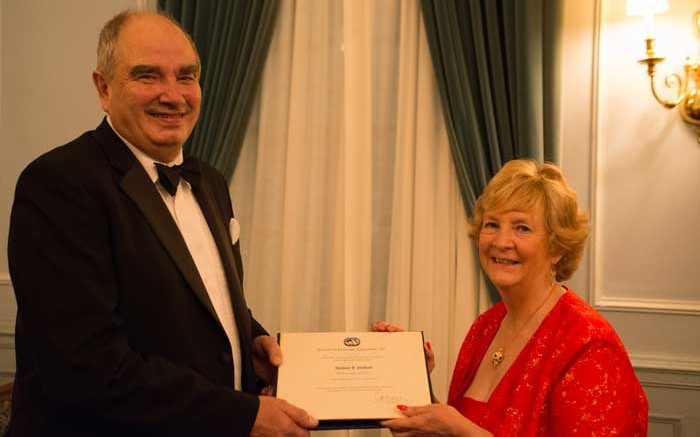To attend the recent dinner at the University of Toronto’s Faculty Club honouring emeritus professor Tony Naldrett was to travel through time to an era when the university was recognized internationally as one of the top institutions for ore deposit research.
“For someone interested in ore deposits, the [geology] department was perhaps the best place in the world to be at the time,” said Naldrett, 79, who joined the faculty in 1967 and went on to become the foremost authority on the geology and origin of nickel-copper-platinum group metals deposits.
Naldrett’s contemporaries included the late Frank Beales, known internationally for his work on Mississippi Valley-type deposits, and Steve Scott, a global expert on sea floor massive sulphide deposits.
In addition to his colleagues (with professor John Rucklidge on piano), the U of T faculty club was packed with Naldrett’s former graduate and undergraduate students, including several who went on to become leaders in the industry such as: Eira Thomas, president of Kaminak Gold and linked to the discovery of the Diavik diamond mine in the Northwest Territories; John Thompson, professor at Cornell University and former vice-president of technology and development for Teck Resources; Matt Manson, president and CEO of Stornoway Diamond; and Maureen Jensen, executive director of the Ontario Securities Commission, who called the audience “the brain trust of the mining business globally.”
A who’s who of geoscience lined up at the podium to laud Naldrett as a man who elicited emotions ranging from “adoration to awe,” including former U of T president and geology department chair David Strangway and the incoming — and first female —president of the Society of Economic Geologists (SEG) Judith Kinnaird.
His former students were equally appreciative, including Thompson, who first met Naldrett in Norway and went on to become one of more than three dozen graduate students under his supervision. “Tony is a giant of ore deposit geology,” he said. “But he never cast a shadow over his graduate students.”
Indeed, Naldrett, who received his undergraduate degree from the University of Cambridge and his PhD from Queen’s University in Kingston, was humble in his closing speech. “When you are embroiled in personal research, you think of your own contribution to science as the most important thing in life,” he said. “It’s only towards the end of your career that you appreciate that your contributions are a mere drop in the bucket compared to the contributions of your students.”
Perhaps Naldrett’s most enduring legacy is his insistence that students question doctrine, a quality that several attending the dinner considered key to their success. “He taught us to think and question expected practice,” Jensen said. “He made us want to think about the right questions to ask.”
That probing nature was ingrained during Naldrett’s “Friends of Fosterite” meetings, regular salon-type gatherings where students were encouraged to discuss geological concepts and push their intellectual boundaries.
During his career, Naldrett authored or co-authored 240 refereed publications and eight books. His research covers most of the world’s magmatic sulphide belts, including Sudbury, Raglan, Thompson, Voisey’s Bay, the West Australian komatiites, the Zimbabwe nickel deposits, Norilsk, Pechenga, Jinchuan, the Duluth, Bushveld and Stillwater complexes, the Great Dyke and Lac des Îles. He has served as a consultant to several companies including Chevron, Falconbridge, Western Mining, BHP Billiton and Rio Tinto.
Naldrett contributed to global scientific discussion by serving as president of the Mineralogical Association of Canada from 1982 to 1983, the SEG from 1991 to 1992, the International Mineralogical Association from 1998 to 2002 and the Geological Society of America from 2001 to 2002. His many awards include the Canadian Institute of Mining, Metallurgy and Petroleum’s Barlow Memorial Medal, the Geological Association of Canada’s Logan Medal and the SEG’s Society and Penrose Gold Medal.
He lives in the cathedral town of Chichester in south-central England and continues to research and consult, particularly on platinum group metals in the Bushveld igneous complex in South Africa.
A graduate student scholarship fund in Naldrett’s name has raised more than $200,000, including a $20,000 donation from Polish copper producer KGHM and $100,000 in matching funds from the U of T.
Fund organizer Ed Spooner, who holds the Keck Chair in Geology, is aiming to raise at least $300,000 for the scholarship. Donations can be made directly at www.donate.utoronto.ca/earthsciences, or by contacting Monica Hahm at monica.hahm@utoronto.ca.
— Virginia Heffernan is a freelance writer specializing in mining issues, and is principal of Toronto-based GeoPen Communications at www.geopen.com.


Be the first to comment on "Naldrett celebration attracts mining’s ‘brain trust’"